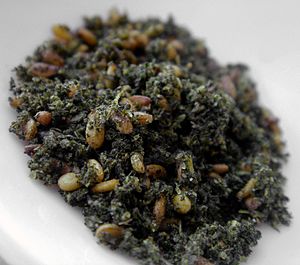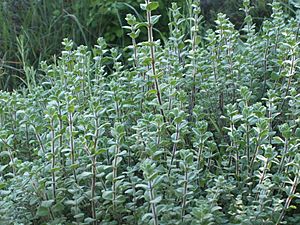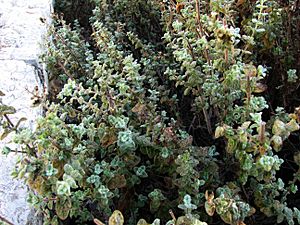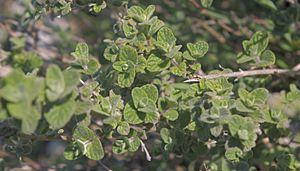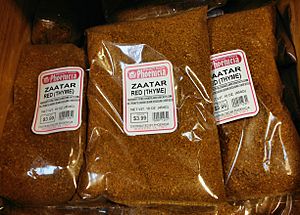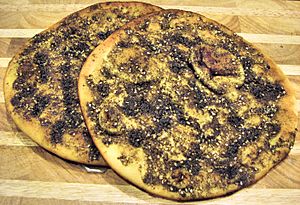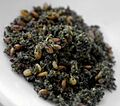Za'atar facts for kids
Za'atar (pronounced ZAH-tar) is a special name for two things: it's a type of herb and also a spice mix. As a herb, za'atar refers to several plants from the Middle East. These plants are related to oregano, thyme, and savory. The most common plant called za'atar is Origanum syriacum.
The spice mix called za'atar is made from this herb. It also includes toasted sesame seeds, dried sumac, and often salt. Sometimes, other spices are added too. Both the herb and the spice mix are very popular in the Middle East and the Mediterranean region.
Contents
What's in a Name?
The word za'atar comes from an old Akkadian word, sarsar, which might have meant a spice plant. It's similar to words in Syriac and Arabic. The Latin name Satureia (for the plant savory) might also be connected.
Many different plants are called "za'atar" depending on the area. For example, Thymus capitatus is a type of wild thyme found in the Levant and Middle East. This thyme is very common in Palestine, and the za'atar spice mix is a popular food there.
Another plant known as "wild za'atar" is Origanum vulgare, also called European oregano. This plant is very common in Lebanon, Syria, Jordan, Israel, and Palestine. People in these areas use it to make their local za'atar spice mix. Other plants like Origanum syriacum (Bible hyssop) and Origanum majorana (sweet marjoram) are also used. These plants are all related and grow in the Mediterranean region.
How Za'atar is Made and Used
Za'atar, as a spice mix, is usually made by drying the Origanum syriacum herb in the sun. Then, it's mixed with roasted sesame seeds and salt. Sometimes, dried sumac berries are added, which give it a reddish color and a tangy taste. If Origanum syriacum isn't available, people use thyme, oregano, or marjoram. Some store-bought versions might even include roasted wheat.
Many families in the Fertile Crescent, Iraq, and the Arabian Peninsula traditionally make their own za'atar mixes. This means there are many different versions, each with its own special touch! Some varieties might include cumin, coriander, or fennel seeds. A special Palestinian za'atar includes caraway seeds, while a Lebanese one has more sumac, making it a dark red color. Like other spice mixes in the Arab world, za'atar is good for you because it has many anti-oxidants.
Za'atar is popular in many countries, including Algeria, Egypt, Iraq, Israel, Jordan, Lebanon, Palestine, Syria, and Turkey.
A Look Back in Time
People have used za'atar plants for a very long time. There's proof that a za'atar plant was known in Ancient Egypt. Parts of Thymbra spicata, a plant used in modern za'atar, were even found in the tomb of Tutankhamun, an ancient Egyptian pharaoh.
In ancient Jewish traditions, the herb ezov mentioned in the Hebrew Bible is believed to be the same as za'atar. This herb was used in important ceremonies for cleanliness. For example, it was used when preparing the ashes of a red cow or for cleaning after certain situations. The ancient Israelites also used ezov branches to put the blood of a special sacrifice on their doorposts before leaving Egypt. King David also spoke about the cleansing power of this herb in the Bible. Later, in the 2nd century CE, za'atar was mentioned as a food ingredient in Judea.
Za'atar has been a common part of Arab cooking from the medieval times until today. For many Palestinian refugees, plants and foods like za'atar are important symbols of their homes and villages.
Today, za'atar is a common herb in Israeli cuisine. Some Israeli companies sell it as "hyssop" or "holy hyssop." However, wild za'atar became very rare in Israel because too many people were picking it. So, in 1977, a law was passed to protect it, making it illegal to pick wild za'atar.
How to Enjoy Za'atar
Za'atar is usually mixed with salt, sesame seeds, and sumac after being dried. A common way to eat it is with pita bread. You dip the bread in olive oil first, then into the za'atar mix. This mix of za'atar and olive oil is called za'atar-wu-zayt or zeit ou za'atar (zeit means "oil" in Arabic).
You can also spread this mixture on dough and bake it to make a delicious bread called manakeesh bi zaatar. In the Middle East, you'll find ka'ak (a soft sesame seed bread) sold in bakeries and by street vendors. You can dip it in za'atar or get it with a za'atar filling.
Za'atar is also used to season meats and vegetables, or sprinkled on top of hummus. It's often eaten for breakfast with labneh (a creamy, tangy yogurt cheese) and bread and olive oil. This is very common in Jordan, Palestine, Israel, Syria, and Lebanon. A Lebanese specialty called shanklish, which are dry-cured balls of labneh, can be rolled in za'atar.
The fresh za'atar herb is used in many dishes too. Borek is a pastry that can be filled with za'atar. A salad made from fresh za'atar leaves is also popular. It's a simple salad with fresh thyme, chopped onions, garlic, lemon juice, olive oil, and salt. In Oman, people even make a herbal tea by steeping za'atar in hot water.
Za'atar and Health
In Palestine, some people believe that za'atar helps make your mind sharp and alert. Because of this, children are sometimes encouraged to eat za'atar for breakfast before school.
Maimonides, a famous doctor and rabbi from the 12th century, wrote about za'atar's health benefits. For a long time, people in the Middle East have thought that za'atar could help get rid of internal parasites.
Images for kids
See also
 In Spanish: Zaʿatar para niños
In Spanish: Zaʿatar para niños


